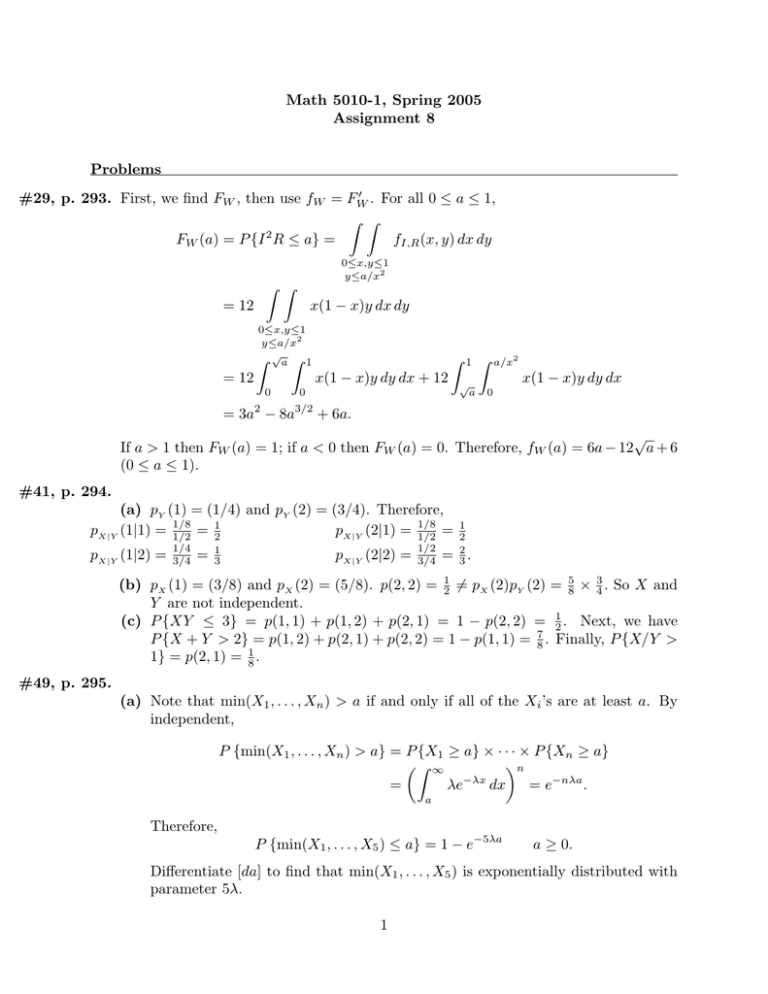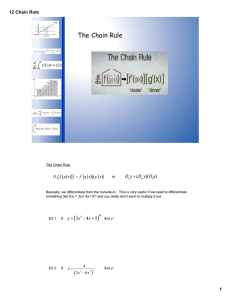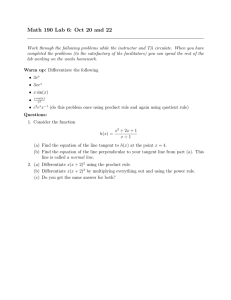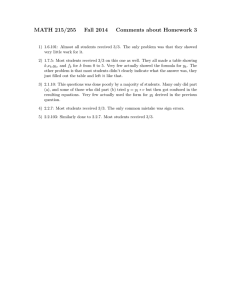Math 5010-1, Spring 2005 Assignment 8 Problems
advertisement

Math 5010-1, Spring 2005
Assignment 8
Problems
0
#29, p. 293. First, we find FW , then use fW = FW
. For all 0 ≤ a ≤ 1,
Z Z
2
FW (a) = P {I R ≤ a} =
fI,R (x, y) dx dy
0≤x,y≤1
y≤a/x2
Z Z
x(1 − x)y dx dy
= 12
0≤x,y≤1
y≤a/x2
Z √a Z 1
Z
x(1 − x)y dy dx + 12
= 12
0
0
1
√
Z
a/x2
x(1 − x)y dy dx
a
0
= 3a2 − 8a3/2 + 6a.
√
If a > 1 then FW (a) = 1; if a < 0 then FW (a) = 0. Therefore, fW (a) = 6a − 12 a + 6
(0 ≤ a ≤ 1).
#41, p. 294.
(a) pY (1) = (1/4) and pY (2) = (3/4). Therefore,
1/8
pX|Y (1|1) = 1/2
= 12
pX|Y (2|1) = 1/8
1/2 =
pX|Y (1|2) =
1/4
3/4
=
1
3
pX|Y (2|2) =
1/2
3/4
=
1
2
2
3.
(b) pX (1) = (3/8) and pX (2) = (5/8). p(2, 2) = 12 6= pX (2)pY (2) = 85 × 43 . So X and
Y are not independent.
(c) P {XY ≤ 3} = p(1, 1) + p(1, 2) + p(2, 1) = 1 − p(2, 2) = 12 . Next, we have
P {X + Y > 2} = p(1, 2) + p(2, 1) + p(2, 2) = 1 − p(1, 1) = 78 . Finally, P {X/Y >
1} = p(2, 1) = 18 .
#49, p. 295.
(a) Note that min(X1 , . . . , Xn ) > a if and only if all of the Xi ’s are at least a. By
independent,
P {min(X1 , . . . , Xn ) > a} = P {X1 ≥ a} × · · · × P {Xn ≥ a}
Z ∞
n
−λx
λe
dx
= e−nλa .
=
a
Therefore,
P {min(X1 , . . . , X5 ) ≤ a} = 1 − e−5λa
a ≥ 0.
Differentiate [da] to find that min(X1 , . . . , X5 ) is exponentially distributed with
parameter 5λ.
1
(b) Similarly,
Z
a
−λx
P {max(X1 , . . . , Xn ) ≤ a} =
λe
n
dx
0
= 1 − e−λa
n
a ≥ 0.
[This is not exponential.]
p
#51, p. 295. Here, R = g1 (X, Y ) and Θ = g2 (X, Y ) where g1 (x, y) = x2 + y 2 and g2 (x, y) =
arctan(y/x). We workedpout the Jacobian of this transformation in lecture. The
end-result is J(x, y) = 1/ x2 + y 2 . Therefore,
fR,Θ (r, θ) = fX,Y (x, y) p
=
r
π
1
x2
+ y2
− π ≤ θ ≤ π, 0 ≤ r ≤ 1.
√
√
#53, p. 295. X = g1 (U, Z) and Y = g2 (U, Z), where g1 (u, z) = 2z cos u and g2 (u, z) = 2z sin u.
The Jacobian of this transformation is J(u, z) = −1. This uses the identity that
sin2 θ + cos2 θ = 1 for all θ. Therefore,
1
| − 1|
= fU (u)fZ (z)
1 −z
1 −(x2 +y2 )/2
=
e =
e
.
2π
2π
fX,Y (x, y) = fU,Z (u, z)
Therefore, fX,Y (x, y) = fX (x)fY (y), where fX (x) =
2
√1 e−x /2 ,
2π
and similarly for fY .
Theoretical Exercises
#18, p. 297.
(a) First compute the conditional cdf. For all a ≤ x ≤ 1,
P {U ≤ x | U > a} =
P {a ≤ U ≤ x}
x−a
=
.
P {U > a}
1−a
Differentiate to find that the conditional pdf of U given that U > a is fU |U >a (x) =
1
1−a for all a ≤ x ≤ 1.
(b) Similarly, for all 0 ≤ x ≤ a,
P {U > x | U ≤ a} =
P {x ≤ U ≤ a}
a−x
=
.
P {U ≤ a}
1−a
1+x−2a
Therefore, P {U < x | U ≤ a} = 1 − a−x
1−a =
1−a . Differentiate to find that the
1
conditional pdf of U given that U < a is fU |U <a (x) = 1−a
for all 0 ≤ x ≤ a.
#20, p. 297. This was worked out in lecture.
2






